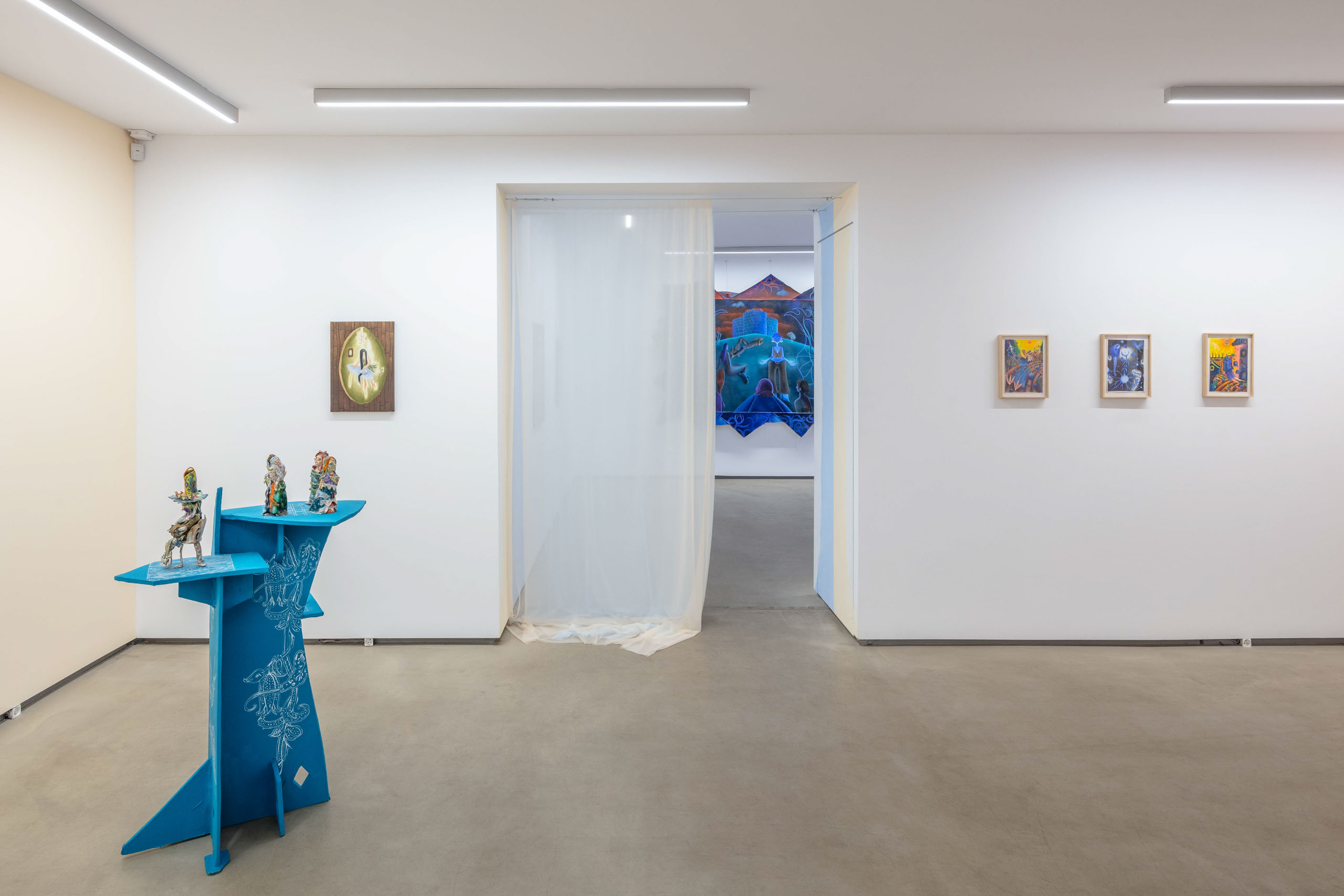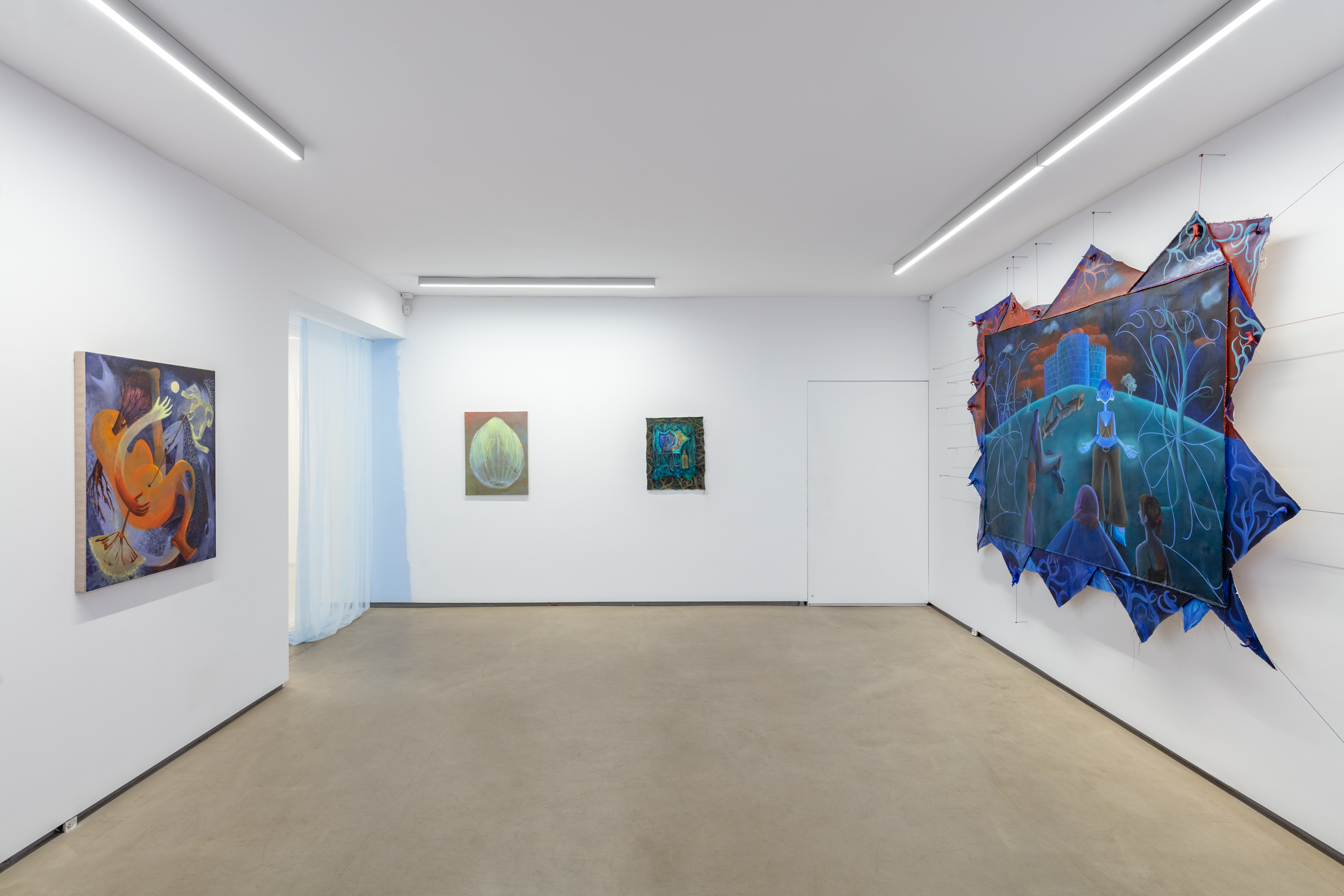Sugar and Salt
June 10 – August 6, 2022
Jagoda Dobecka, Dominika Dobiášová, Bartłomiej Hajduk, Emily Hunt, Klára Jakeš, Øleg&Kaśka, Nina Paszkowski, Magdalena Starska
Curated by Marcelina Grześkiewicz and Franciszek Smoręda
In the story we are recounting, the proportion of sugar and salt is evenly distributed. The narrative is based on a traditional English fairy tale about a father and two daughters. The question about the sweetest thing in the world leads to quarrels, anger, and eventually the exile of one of the daughters. The dispute is over sugar and salt. The kitchen ceases to be a place for storing sweet and salty crystals. Let us treat them as symbolic orders that do not contradict each other. They remain in harmony and complement each other, creating a complex vision of reality.
The ballad about the cycle of life, death, reincarnation, and interspecies unity begins with a nymph in a bridge position by Øleg&Kaśka. In her body circulates water, an uncontrollable element heralding inception and vitality, as well as chaos and destruction. The figure resembles a triumphal arch, inviting newcomers to cross the threshold of an enchanted space. Magdalena Starska’s watercolours depict landscapes, which provide a place for animated nature to frolic. The artist grants full subjectivity to nature, and the human silhouette merely becomes a barely perceptible shape. The rituals of ploughing, sowing, and harvesting are repeated in the drawings by Bartłomiej Hajduk. The roles of female farmers are played by human-bird hybrids, sowers of an interspecies alliance. In these scenes, the boundary between the world of the living and the dead is blurred. Spaces full of fertile crops are traversed by ghosts captivated in an endless dance of life and death. Nina Paszkowski seems to be reconsidering the questions of where we come from, what we are, and where we are going. Answering them, she draws on esoteric and alternative orders of representing the life continuum. She refers to the mysterious work of Leonora Carrington and domestic magical practices. Emily Hunt’s ceramic figures assume the form of psychedelic sages, forest witches, elves, or the Roman god Janus, here subversively rendered as a woman, although Hunt’s figures usually escape binary divisions. The witches have been immortalized in the moment of organic acts of creation, while the elves gathered in the circle appear disturbingly similar to ourselves. We become confidants of their confessions, unwittingly observing the process of group therapy. Klára Jakeš’s sugar-coated reliefs allude to the Sorbian legend of Krabat, an orphan who sets out on a vendetta against the evil sorcerer. The artist weaves a folk tale about the heroic character in the vein of the grotesque. The quoted story becomes an opportunity to pay tribute to marginalised individuals, and thus to politicise imagined reality. The death of a loved one is the main narrative axis of Jagoda Dobecka’s sound essay. The moving story, hidden in a pansy-shaped cushion, is an analysis of the social taboo of death and mourning. Starting from personal experience, the artist creates a stream of thought blurring the distinction between private and public, investigating the subject of loss through cultural texts, theories, and contemporary economic conditions. Suspended freely in space, Dominika Dobiášová’s canvases herald another dimension. The heroines of her paintings gather amidst a medieval setting. They are led by a spiritual leader portrayed in an apocryphal pose. At other times, the figures make a pact with celestial bodies.
“Indeed, salt is the sweetest thing in the world,” the father admits at the end of the tale. The question posed at the very beginning might seem trivial, and the answer obvious. Looking through the kaleidoscope of the presented works, the assumed divisions are no longer justified. The life cycle ceases to be linear. Inter-species unity is possible. Other dimensions seem to be much closer than we might think. Lemon, sugar, or salt can possess their own magical properties. A concoction prepared in this way is an expression of affirmation of life, acceptance of death, blurring the boundaries between them. A cocktail with a familiar taste, not too sweet, not too salty.









